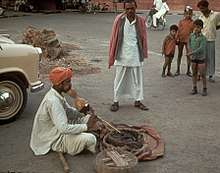Pungi
The Pungi (Hindi: पुंगी),[1]also called the Been (बीन), and the Murli, is a wind instruments played by snake charmers in the Indian subcontinent. The instrument consists of a mouth-blown air reservoir made from a gourd that channels air into two reedpipes. It is played with no pauses as the player employs circular breathing. It originated in India and is still played by snake charmers in street performances.

History
The Pungi[2][3][4] is an Indian folk music instrument[1] that is mostly played by cobra charmers[5] in Sindh Pakistan and Rajasthan.[6] This instrument is made from a gourd,[7] and has been referred to as a double-reed instrument.[8] The Pungi is played by Jogi or Jogis in the streets of the Thar desert and Sindh.[9]
The Pungi is also played by traditional and folk musicians to produce musical melodies. It was theorized to put people into a half-conscious states, as a part of religious practice, and not just for snake charming.[10] It is particularly played by snake charmers to arouse snakes to dance, mostly in Terai regions and Nepal.[11]
The pitch of the Pungi is high and thin in tone. It is also described to sound like a continuous low humming and fast tone fortune or melody.[10]
It has always been an important musical instrument in the folk culture of India and is known by various names in different parts of the country. Some of its popular colloquial names are Been, Tumbi and Bansi in northern India while in the southern part of the country it is known as Magudi, Mahudi, Pungi, and Pambaattikuzhal. [12]
Construction
The Pungi is constructed from a solid cover of coconut by fitting pieces of bamboo in it. The instrument has two components: the first part is constructed from a dry and swollen gourd that is hollowed; the second part is made from two jointed double-reed pipes that have holes.[13] The reed portion often has eight holes, but in some areas of Sindh, Pakistan it has an extra hole in the right pipe.[13]
The Pungi player blows air through the top tube-like portion of the instrument. The joint double-reed pipes are known as Jivala, wherein one pipe makes a drone-like sound whereas the second pipe produces a melodious tune. The melody pipe has seven holes with a range of one octave. The drone pipe has only one fingerhole. When the two sounds come out simultaneously and are played continuously by a circular breathing technique, it creates a hypnotic ambience.
It is played individually and is difficult to pair it with other musical instruments.[14]
Major use ban
Its major use was to entertain the public for snake charming, which was eventually banned throughout the country under the Wildlife Protection Act, 1972 in 1991.
See also
- Hulusi, a similar Chinese instrument.
References
- Avtar, Ram (1983). Musical instruments of India: history and development. Pankaj Publications.
- "A Seductive Musical Affair – The UrbanWire". The UrbanWire. 2010-06-01. Retrieved 2018-04-07.
- Manzar, Osama (2016-03-02). "Social media can save folk and oral wisdom". Mint. Retrieved 2018-04-07.
- "Fading sounds of tribal rhythms - Times of India". The Times of India. Retrieved 2018-04-07.
- "Our dying cultural heritage - The Express Tribune". The Express Tribune. 2011-07-09. Retrieved 2018-04-07.
- "Fusion of styles, cultures & continents at this year's International Folk Festival - The Sunday Guardian Live". The Sunday Guardian Live. 2016-10-22. Retrieved 2018-04-07.
- Balocu, Nabī Bak̲h̲shu K̲h̲ānu (2012). Musical Instruments of the Lower Indus Valley of Sindh. Culture Department, Government of Sindh.
- Booth, Gregory D.; Shope, Bradley (2014). More Than Bollywood: Studies in Indian Popular Music. Oxford University Press. ISBN 9780199928835.
- "Transcendental tradition: Under the spell of Sindhi snake charmers - The Express Tribune". The Express Tribune. 2013-10-14. Retrieved 2018-04-07.
- "Asian Sub-continent: India, Pakistan,". www.rootsworld.com. Retrieved 2018-04-08.
- "Nepali Musical Instruments - We All Nepali". www.weallnepali.com. Retrieved 2018-04-08.
- http://www.schoolchalao.com/basic-education/show-results/indian-musical-instruments/pungi-or-been
- "Instruments of Pakistan | American Institute of Pakistan Studies". pakistanstudies-aips.org. Retrieved 2018-04-08.
- https://www.india-instruments.com/windinstrument-details/pungi-snake-charmer-been-shapure-bansi.html
